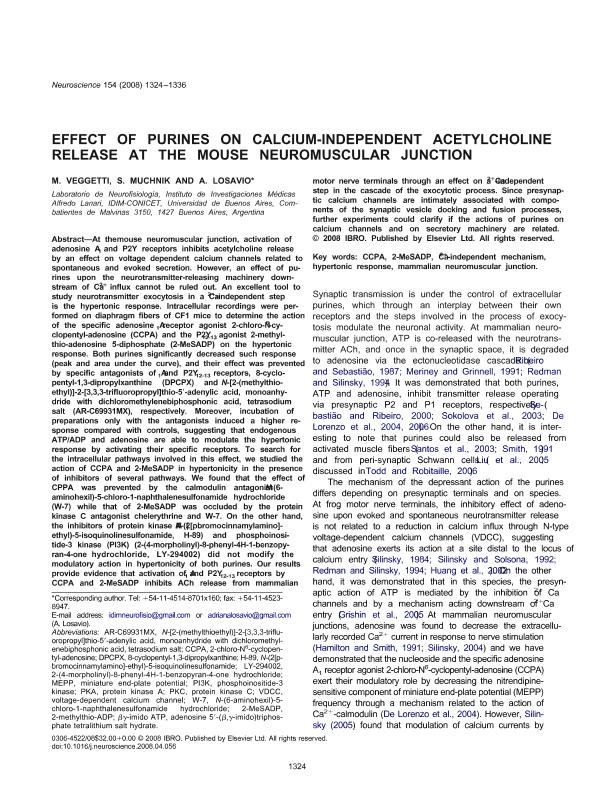Artículo
Effect of purines on calcium-independent acetylcholine release at the mouse neuromuscular junction
Fecha de publicación:
07/2008
Editorial:
Pergamon-Elsevier Science Ltd
Revista:
Neuroscience
ISSN:
0306-4522
Idioma:
Inglés
Tipo de recurso:
Artículo publicado
Clasificación temática:
Resumen
At the mouse neuromuscular junction, activation of adenosine A1 and P2Y receptors inhibits acetylcholine release by an effect on voltage dependent calcium channels related to spontaneous and evoked secretion. However, an effect of purines upon the neurotransmitter-releasing machinery downstream of Ca2+ influx cannot be ruled out. An excellent tool to study neurotransmitter exocytosis in a Ca2+-independent step is the hypertonic response. Intracellular recordings were performed on diaphragm fibers of CF1 mice to determine the action of the specific adenosine A1 receptor agonist 2-chloro-N6-cyclopentyl-adenosine (CCPA) and the P2Y12-13 agonist 2-methylthio-adenosine 5′-diphosphate (2-MeSADP) on the hypertonic response. Both purines significantly decreased such response (peak and area under the curve), and their effect was prevented by specific antagonists of A1 and P2Y12-13 receptors, 8-cyclopentyl-1,3-dipropylxanthine (DPCPX) and N-[2-(methylthioethyl)]-2-[3,3,3-trifluoropropyl]thio-5′-adenylic acid, monoanhydride with dichloromethylenebiphosphonic acid, tetrasodium salt (AR-C69931MX), respectively. Moreover, incubation of preparations only with the antagonists induced a higher response compared with controls, suggesting that endogenous ATP/ADP and adenosine are able to modulate the hypertonic response by activating their specific receptors. To search for the intracellular pathways involved in this effect, we studied the action of CCPA and 2-MeSADP in hypertonicity in the presence of inhibitors of several pathways. We found that the effect of CPPA was prevented by the calmodulin antagonist N-(6-aminohexil)-5-chloro-1-naphthalenesulfonamide hydrochloride (W-7) while that of 2-MeSADP was occluded by the protein kinase C antagonist chelerythrine and W-7. On the other hand, the inhibitors of protein kinase A (N-(2[pbromocinnamylamino]-ethyl)-5-isoquinolinesulfonamide, H-89) and phosphoinositide-3 kinase (PI3K) (2-(4-morpholinyl)-8-phenyl-4H-1-benzopyran-4-one hydrochloride, LY-294002) did not modify the modulatory action in hypertonicity of both purines. Our results provide evidence that activation of A1 and P2Y12-13 receptors by CCPA and 2-MeSADP inhibits ACh release from mammalian motor nerve terminals through an effect on a Ca2+-independent step in the cascade of the exocytotic process. Since presynaptic calcium channels are intimately associated with components of the synaptic vesicle docking and fusion processes, further experiments could clarify if the actions of purines on calcium channels and on secretory machinery are related.
Palabras clave:
CCPA
,
2-MeSADP
,
HYPERTONIC RESPONSE
,
MAMMALIAN NEUROMUSCULAR JUNCTION
Archivos asociados
Licencia
Identificadores
Colecciones
Articulos(IDIM)
Articulos de INST.DE INVEST.MEDICAS
Articulos de INST.DE INVEST.MEDICAS
Articulos(OCA HOUSSAY)
Articulos de OFICINA DE COORDINACION ADMINISTRATIVA HOUSSAY
Articulos de OFICINA DE COORDINACION ADMINISTRATIVA HOUSSAY
Citación
Veggetti, Mariela Iris; Muchnik, Salomon; Losavio, Adriana Silvia; Effect of purines on calcium-independent acetylcholine release at the mouse neuromuscular junction; Pergamon-Elsevier Science Ltd; Neuroscience; 154; 4; 7-2008; 1324-1336
Compartir
Altmétricas




